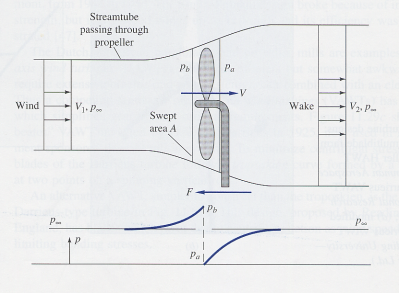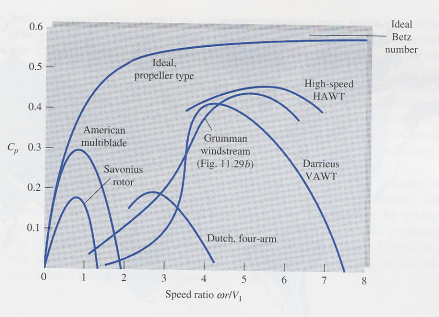Pumping Systems: Parallel and Series Configurations
For some piping system designs, it may be desirable to consider a multiple pump system to meet the design requirements. Two typical options include parallel and series configurations of pumps. Specific performance criteria must be met when considering these options.
Given a piping system which has a known design flow rate and head requirements, Qdes, hdes, the following pump selection criteria apply.
Pumps in Parallel: |
|
Pumps in Series: |
|
For example, if the design point for a given piping system were Qdes = 600 gpm, and hsys = 270 ft, the following pump selection criteria would apply:
1. Single pump system |
Q(pump) = 600 gpm, hp = 270 ft |
2. Parallel pump system |
Q(pump) = 300 gpm, hp = 270 ft |
3. Series pump system |
Q(pump) = 600 gpm, hp = 135 ft |
Example 11.6
It is desired to use the 32 in. pump of Fig. 11.7a at 1170 rpm to pump water at 60˚C from one reservoir to another 120 ft higher through 1500 ft of 16 in. ID pipe with f = 0.030. Determine the operating point (hp & Q) and the pump power requirements and efficiency. Fig. E11.6 Head and system curves vs Q |
|
Neglecting minor losses, the energy equation can be written between the surfaces of the two reservoirs. Note that for these conditions the velocities at the reservoir surfaces is zero and kinetic energy change can be neglected.

Since from continuity we know that Q = V A = (p D2/4) V, the energy equation becomes
![]() with Q in ft3/s
with Q in ft3/s
Converting the flow rate Q to thousands of gal/min to be consistent with Fig. 11.7a we obtain
![]() with Q in 103 gpm
with Q in 103 gpm
Plotting the results for the system head and pump head vs. flow rate as shown in Fig. E11.6 we can graphically read a solution as
H = 430 ft and Q = 15,000 gpm
From Fig. 11.7a, the pump power and efficiency at the operating point are
BHP @ 2000 hp and h @ 80%
It is noted that a more common piping / pump system design and selection problem would proceed as follows:
(1) The basic geometry, components and specifications of a piping system would be specified including a known design flow rate, Qdes.
(2) Solve the energy equation for hsys for a range of flow rates including Qdes.
(3) Plot the system head curve vs flow rate and identify the design head requirements hdes at Qdes.
(4) Review pump curves from various manufacturers to identify several pumps or pump systems capable of providing hp @ hdes at Qdes.
(5) Select final choice for pump or pump system to meet design based on additional factors such as (a) closeness of hp to hdes, (b) pump efficiency
and power requirements at design point, (c) pump costs.
Wind Turbines
Wind energy has been used to supply mechanical power for irrigation and electrical power for many years. Modern technology has led to the development of wind turbine systems that are beginning to see extensive use to supply electrical power for the power grid system in many countries. A simple streamtube model as shown in Fig. 11.30 will be used to develop a basic analysis for wind turbine performance.

Fig. 11.30 Streamtube model for flow through a wind turbine
Consider the control volume shown in Fig. 11.30, the momentum equation can be written between points 1 and 2 as
![]()
Likewise, considering the control volume just before and after the disk, the momentum equation can be written as
![]()
Equating these equations, we obtain for the propeller force
![]()
The incompressible Bernoulli equation can be written before and after the disk to obtain
From 1 to b ![]()
From a to 2 ![]()
Note that we have defined the velocity V as the wind velocity at the disk swept area A. The mass flow rate is then given by ![]() .
.
Subtracting the last two equations gives
![]() with
with ![]()
Thus, it is seen that an average velocity V at the disk face that is equal to the average of upstream wind and far wake speeds will satisfy both conservation of mass and momentum.
The power delivered by the disk is given by
![]()
The maximum possible power for a given wind speed V1 is obtained by differentiating P with respect to V2 and yields
![]() and
and ![]()
The maximum available power is the power associated with the kinetic energy of the approaching wind at the mass flow through the disk. This is given by
![]()
The maximum possible efficiency for an ideal frictionless wind turbine can then be expressed in terms of a power coefficient defined as

The maximum power coefficient is then given by

and is referred to as the Betz number. It provides an upper limit with which to compare the performance of actual wind turbines.
Figure 11.31 on the following page presents estimated performance curves of several wind turbine designs as a function of blade-tip speed ratio.

Source: http://www.eng.auburn.edu/~tplacek/courses/2610/samba/CHEN2610FacultyCh11c.doc
Web site to visit: http://www.eng.auburn.edu/
Author of the text: indicated on the source document of the above text
If you are the author of the text above and you not agree to share your knowledge for teaching, research, scholarship (for fair use as indicated in the United States copyrigh low) please send us an e-mail and we will remove your text quickly. Fair use is a limitation and exception to the exclusive right granted by copyright law to the author of a creative work. In United States copyright law, fair use is a doctrine that permits limited use of copyrighted material without acquiring permission from the rights holders. Examples of fair use include commentary, search engines, criticism, news reporting, research, teaching, library archiving and scholarship. It provides for the legal, unlicensed citation or incorporation of copyrighted material in another author's work under a four-factor balancing test. (source: http://en.wikipedia.org/wiki/Fair_use)
The information of medicine and health contained in the site are of a general nature and purpose which is purely informative and for this reason may not replace in any case, the council of a doctor or a qualified entity legally to the profession.
The texts are the property of their respective authors and we thank them for giving us the opportunity to share for free to students, teachers and users of the Web their texts will used only for illustrative educational and scientific purposes only.
All the information in our site are given for nonprofit educational purposes